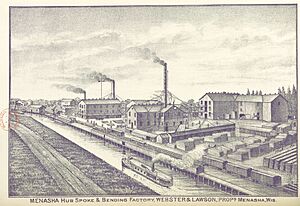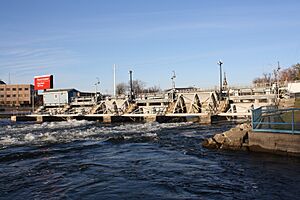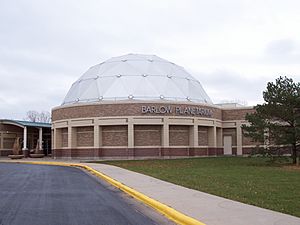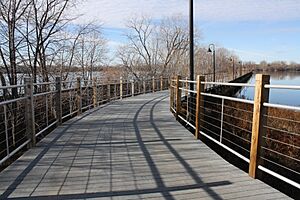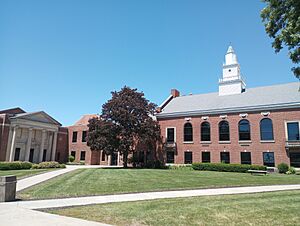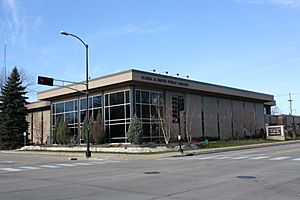Menasha, Wisconsin facts for kids
Quick facts for kids
Menasha, Wisconsin
|
|
|---|---|
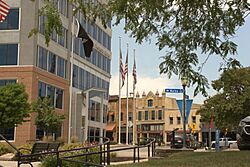
Downtown Menasha
|
|
| Motto(s):
"Your Place on the Water"
|
|
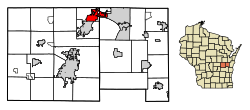
Location of Menasha in Calumet County, Wisconsin.
|
|
| Country | |
| State | |
| Counties | Winnebago, Calumet |
| First settled | 1835 |
| Incorporated as a town | 1848 |
| Incorporated as a city | 1874 |
| Named for | Winnebago word for "Island" |
| Government | |
| • Type | Mayor-council government |
| Area | |
| • Total | 7.78 sq mi (20.16 km2) |
| • Land | 6.05 sq mi (15.66 km2) |
| • Water | 1.74 sq mi (4.50 km2) |
| Elevation | 755 ft (230 m) |
| Population
(2020)
|
|
| • Total | 18,268 |
| • Estimate
(2019)
|
17,873 |
| • Density | 3,021.5/sq mi (7,825.64/km2) |
| Demonym(s) | Menashan |
| Time zone | UTC−6 (Central (CST)) |
| • Summer (DST) | UTC−5 (CDT) |
| ZIP code |
54952
|
| Area code | 920 |
| FIPS code | 55-50825 |
| GNIS feature ID | 1569330 |
| Website | menashawi.gov |
Menasha is a city in Wisconsin, USA. It is located in both Calumet and Winnebago counties. In 2020, about 18,268 people lived there. The name "Menasha" comes from a Native American word meaning "thorn" or "island." In the Menominee language, it means "little island."
Menasha is part of the Fox Cities area in Wisconsin. A part of Doty Island is also in Menasha, shared with the city of Neenah. The city's location on the Fox River and Lake Winnebago has shaped its long history. Native American tribes lived here for many centuries. In the 1800s, European settlers arrived. Menasha became a key place for transportation and later for making paper and wooden products. Today, Menasha is home to the Barlow Planetarium and the Weis Earth Science Museum. These are both located at the University of Wisconsin–Oshkosh, Fox Cities Campus.
Contents
History of Menasha
Long ago, the ancestors of the Ho-Chunk people lived where Menasha is now. In the 1600s, the Meskwaki tribe built a village just north of Menasha. French soldiers and traders attacked them, and most of the Fox Native Americans in the area died. People say their bodies were piled into a large mound. This mound became known as Butte des Morts, which means "Hill of the Dead." This landmark was removed when a railroad was built in 1863.
In 1836, the land was given to the United States in the Treaty of the Cedars. This meant the land could be sold to the public. James Duane Doty, who was the governor of the territory, was one of the first people to buy land here. In 1848, Doty and his partners, including Curtis Reed, started the town of Menasha. It was on the channel north of Doty Island.
In 1849, Reed and Doty convinced the U.S. government to put the main shipping route for the Fox-Wisconsin waterway through Menasha. This made Menasha an important place for boats. In 1854, Menasha agreed to spend $150,000 to bring the Manitowoc & Mississippi Railroad to the city. The goal was to make Menasha the main transportation center in Wisconsin. Menasha officially became a city in 1874.
In the early 1900s, Menasha started making a lot of paper. Many paper mills were in the city. These included the George A. Whiting Paper Company Mill and the John Strange Paper Mill. Menasha also had the George Banta Publishing Company. This company printed textbooks, military manuals, yearbooks, and magazines.
The Menasha Corporation also started here. It was founded in 1849 by Elisha D. Smith as Menasha Wooden Ware. This company made wooden containers like butter tubs and barrels. It grew to be the biggest maker of wooden products in the world. After wooden products were used less in the early 1900s, the company changed. It started making corrugated packaging and changed its name to Menasha Corporation.
Geography and Location
Menasha is located at 44.2129 degrees North and 88.4362 degrees West. The city covers about 7.52 square miles (19.48 square kilometers). About 6.03 square miles (15.62 square kilometers) is land, and 1.49 square miles (3.86 square kilometers) is water.
Population and People
| Historical population | |||
|---|---|---|---|
| Census | Pop. | %± | |
| 1860 | 1,436 | — | |
| 1870 | 2,484 | 73.0% | |
| 1880 | 3,144 | 26.6% | |
| 1890 | 4,581 | 45.7% | |
| 1900 | 5,589 | 22.0% | |
| 1910 | 6,081 | 8.8% | |
| 1920 | 7,214 | 18.6% | |
| 1930 | 9,062 | 25.6% | |
| 1940 | 10,481 | 15.7% | |
| 1950 | 12,385 | 18.2% | |
| 1960 | 14,647 | 18.3% | |
| 1970 | 14,836 | 1.3% | |
| 1980 | 14,728 | −0.7% | |
| 1990 | 14,711 | −0.1% | |
| 2000 | 16,331 | 11.0% | |
| 2010 | 17,353 | 6.3% | |
| 2020 | 18,268 | 5.3% | |
| U.S. Decennial Census | |||
Menasha is part of a larger area called the Appleton–Oshkosh–Neenah Combined Statistical Area. This area includes Appleton, Oshkosh, and Neenah. In 2010, this larger area had a population of 392,660 people.
2020 Census Information
In 2020, there were 18,268 people living in Menasha. Most residents, about 85.9%, were White. Other groups included 1.8% African American, 1.3% Native American, and 3.1% Asian. About 7.2% of the population was Hispanic or Latino.
2010 Census Information
In 2010, Menasha had 17,353 people living in 7,405 households. The average household had 2.32 people. About 30.7% of households had children under 18 living with them. The average age of people in Menasha was 36 years old. About 24.8% of residents were under 18.
Places of Worship
The Wisconsin Evangelical Lutheran Synod (WELS) has two churches in Menasha: Bethel Lutheran Church and Mount Calvary Lutheran Church. Harry Weese, a famous architect, designed Menasha's St Thomas' Episcopal Church.
Parks and Fun Things to Do
The Heckrodt Wetland Reserve is a special nature area in the city. It has 91 acres with different habitats like wetlands, marshes, and prairies. You can see many plants and animals there.
The University of Wisconsin–Oshkosh, Fox Cities Campus is home to two cool places:
- The Weis Earth Science Museum: Here you can learn about rocks, minerals, and the Earth's history.
- The Barlow Planetarium: This is a theater where you can watch shows about stars, planets, and space.
Menasha has many parks. Jefferson Park has a public swimming pool. Smith Park is the oldest park in Menasha, started in 1897. In Smith Park, there's an old railroad caboose. It reminds people of the first Wisconsin Central Railroad. The south end of the park has Native American burial mounds. There's also a natural amphitheater used for summer concerts. The north end of the park has beautiful gardens with about 6,000 flowers planted each year. It's a popular spot for summer weddings. A gazebo was built here in 1997.
Schools and Learning
The Menasha Joint School District runs the public schools in Menasha. It has:
- One high school: Menasha High School
- One middle school
- Five elementary schools
Menasha is also home to the University of Wisconsin–Oshkosh, Fox Cities Campus. This is a two-year college campus that is part of the UW System.
Friendly Cities
Menasha has a "friendly city" relationship with:
 Maebashi, Japan
Maebashi, Japan
Famous People from Menasha
- Joseph H. Anderson, a lawmaker
- Connie Clausen, an actress and writer
- Samuel A. Cook, a U.S. Representative
- John Dollard, a psychologist
- Eric Hinske, a baseball coach and former player
- James C. Kerwin, a judge on the Wisconsin Supreme Court
- Dave Koslo, a Major League Baseball player
- Jean Kraft, an opera singer
- Publius Virgilius Lawson, a mayor and historian
- George Liberace, a musician
- Jeff Loomis, a heavy metal guitarist
- Thomas J. O'Malley, Lieutenant Governor of Wisconsin
See also
 In Spanish: Menasha (Wisconsin) para niños
In Spanish: Menasha (Wisconsin) para niños


